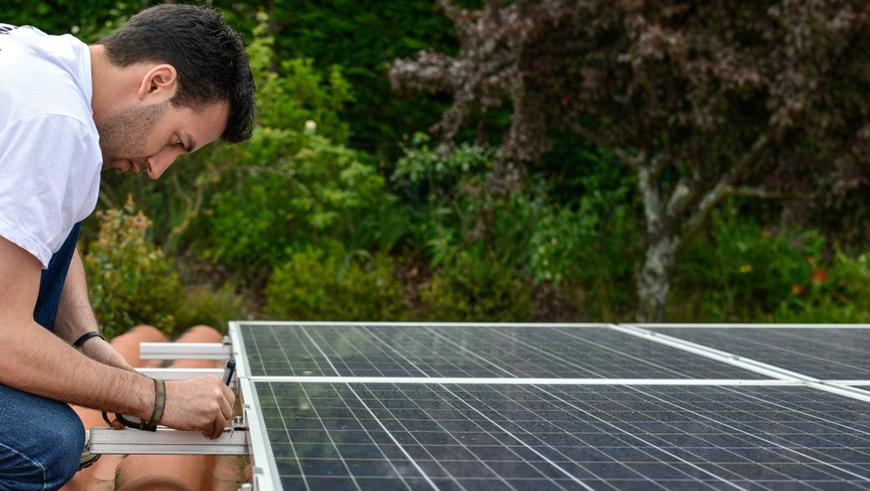Solar Roof Tiles Cost
Last updated 10th June, 2025
Looking into solar roof tiles?
If you've been thinking about solar tiles then this guide is perfect for you! From PV roof tiles (photovoltaic tiles) to solar roof installation fees. We've got you!
Let's get started!

Table of Contents
Solar Roof Tile Prices
The average cost will normally be charged at around £100 to £200 per day to install solar roof tiles. Specialists will often work in pairs to ensure the job is done correctly and efficiently. Depending on the size of your roof, you can expect solar roof tile installation to take anywhere from 1-2 weeks to complete.
The material cost to install solar roof tiles will depend on which solar system size is best suited to your property.
3kW or 4kW solar tiles are recommended for the average household, and should cover the total energy usage for your home. Alternatively 1kW and 2kW are viable for 1 or 2 people, although this could be a stumbling block if selling your property to a larger family at a later date.
Below are some estimated costs of hiring a specialist to install solar roof tiles:
| Job Description | Avg. Cost | Duration |
|---|---|---|
| Install 1kW solar tiles | £6000 | 1-2 weeks |
| Install 2kW solar tiles | £8000 | 1-2 weeks |
| Install 3kW solar tiles | £11,000 | 1-2 weeks |
| Install 4kW solar tiles | £13,000 | 1-2 weeks |
Solar roof tiles are a new alternative to solar panels offering a more subtle look they are quite unobtrusive on the roof whilst offering the benefits of renewable energy.
Whereas solar panels can look quite out of place and even ugly on roofs, solar tiles blend into the surrounding roof tiles pretty well yet still offer cheaper bills and lower carbon emissions. However, the performance and costs of solar tiles are generally not as impressive as conventional solar panels.
Solar Roof Tiles Cost Breakdown Calculator
Individual costs to install 3kW solar tiles- Total Cost: £11,000
Materials
£8250
Tradesmen
£2200
Waste Removal & Scaffolding
£550
What Does Installing Solar Roof Tiles Involve?
The actual installation will usually involve erecting scaffolding and is much the same process as replacing a roof, plus of course, the tiles need to be connected and wired up to an inverter connected to your electricity supply and the electric meter.
Solar tiles cannot be fixed to a roof in poor condition, so any rotten or damaged timbers or battens will need to be replaced. You may also want to replace any other roof timbers such as fascia boards, soffits and guttering, while you already have paid to have the scaffolding in place to save some money.
If your home electrical system has not been replaced for 20 years and you still have an old-fashioned fuse-box, you will also need to budget for complete rewiring plus the fitting of a modern consumer unit.
Whilst solar tiles do look great, they cost much more than solar panels, often costing up to twice as much! They are also still a relatively new technology, so at the moment they are around 10-20% less efficient than conventional solar panels. In general, solar tiles are more popular with new build properties where the solar tiles can be fitted across the roof without removing the existing tiles.
Be very wary of attempting to fit solar tiles as a DIY project. They are a pretty new technology so really should be fitted by professionals to avoid any problems.
Solar Roof Tiles vs Solar Panels
The main reason homeowners use solar tiles as opposed to traditional panels is they simply look much better. Solar tiles offer the benefits of renewable energy, without the unsightly appearance of solar panels fixed to a frame on the rooftop.
Installing solar tiles means simply replacing some or all of your existing roof tiles with photoelectric panels, while keeping as close to the look and feel of a traditional roof as possible. Whereas solar panels are more intrusive aesthetically speaking.
However, if you wish to compare solar roof tiles with solar panels, we've provided a bit of a pros and cons list for both options:
Installing Solar Roof Tiles
Pros
- ✔ Ideal for new builds or to install when replacing old roof tiles
- ✔ Provides a sleek, modern design, that easily blends into your roof design
- ✔ No mounting racks required as roof tiles blend naturally into your roof
Cons
- ✖ More expensive than regular solar panels
- ✖ Less efficient, so requires a larger area to be covered
- ✖ Long-lasting, but harder to service
Installing Solar Panels
Pros
- ✔ High efficiency (18%-22%) so more power per panel
- ✔ Lower installation cost, making it more affordable
- ✔ Established technology that's widely available
Cons
- ✖ Bulky and heavy, visually unappealing
- ✖ Potential roof damage - additional cost
- ✖ May not be suitable for all roof designs
While solar roof tiles are a modern alternative, it's worth doing your research by comparing against the cost of installing solar panels and deciding which is best suited to your requirements.
Solar Roof Tile Incentives
If you purchase solar tiles from an accredited supplier and get your solar roof tile installer's MCS certificate once the work is completed, you can join the Smart Export Guarantee.
Then, you can apply for the Government incentive schemes and start receiving tax-free payments for the next twenty years, potentially earning yourself as much as £12,000 at an average of £600 per year.
What's more, these payments aren't taxable and don't count towards your personal tax allowance either. As such, not only doing your bit for the environment and saving money in the long run, but you also stand to make a profit.
Other incentives for installing solar roof tiles include:
- Newer technology than solar panels
- Solar power can help reduce energy bills
- Renewable energy source
- Reducing your carbon footprint
- Increases your property value
Government-Led Solar Power Initiatives
The FiT (Feed-in Tariff) and SEG (Smart Export Guarantee) are both UK government schemes designed for the encouragement of using renewable energy.
Although the Feed-in Tariff is no longer open for new applicants (since 2019) it's worth understanding how this worked alongside the Smart Export Guarantee, as the latter has since changed to accommodate both under one umbrella.
Individually this would mean anyone registered as using solar panels, or in this case solar roof tiles, would effectively receive two payments:
- Generation Tariff - calculated by the total amount of renewable energy generated
- Export Tariff - calculated by the amount of renewable energy exported back into the National Grid
In other words, payment in return for not only the amount of energy you generate, but also the amount of energy you put back into the wider community.
Since the opportunity for new applicants for the FiT scheme has closed, the payment rate is no longer implemented by the government but instead comes from the energy suppliers themselves.
DIY Solar Roof Tiles Installation
Although technically possible, it is strongly recommended not to carry out installing your solar roof tiles as a DIY project.
Aside from the risk element of working high up on your roof, there's also the fact it is indeed a complicated job to take on by yourself.
One that not only comes with safety concerns, but also technical ones too. As part of standard building regulations, any work should be carried out without any damage to the structural integrity of the building.
It is also important that the installation meets Part P of the Building Regulations referring to electrical safety standards. If you are not a qualified electrician then you would need to contact your local building control to inform them of the work.
If you plan to export energy back to the National Grid, you will need to contact the Distribution Network Operator (DNO), after which you may find they will only accept professional installations with the official documentation.
So, ultimately, if you buy cheap tiles online and fit them yourself, you will also miss out on any government incentives. In the end meaning a DIY solar tiles installation will actually cost you a lot more in the long run!










